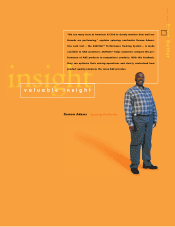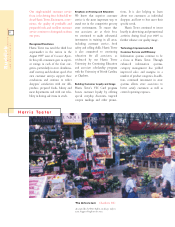Harris Teeter 1997 Annual Report Download - page 17
Download and view the complete annual report
Please find page 17 of the 1997 Harris Teeter annual report below. You can navigate through the pages in the report by either clicking on the pages listed below, or by using the keyword search tool below to find specific information within the annual report.
Even Better
1997 ANNUAL REPORT
1115
Other Effects on Results of Operations
During the second fiscal 1996 quarter, the Company elected
to begin paying directly to its ESOP employee-sharehold-
ers the cash dividends on ESOP shares. Favorable tax
treatment of the ESOP dividend pass-through under the
applicable income tax statutes along with favorable tax
attributes of COLI reduced the effective income tax rate of
the Company. The favorable tax attributes of COLI,
however, were significantly diminished as of January 1, 1996
as a result of federal legislation which will phase out inter-
est deductions on policy loans by January 1, 1999.
On January 23, 1996, certain assets of Jordan
Graphics, Inc., a subsidiary of the Company, were sold to
The Reynolds and Reynolds Company. The revenues of
the discontinued operations for the fiscal year prior to the
sale were $17.3million. The operating results for fiscal
years 1996 and 1995 were not significant. Substantially all
the value of assets of Jordan was realized during fiscal year
1996 by collection or sale. The disposition had no signifi-
cant impact on the consolidated earnings or the financial
condition of the Company. The business forms segment
was reported as discontinued operations.
In fiscal 1996, Ruddick Investment Company, a sub-
sidiary of the Company, redefined its business, with major
emphasis on the development of selected sites for Harris
Teeter stores. Venture capital investment holdings continue
to be managed but future equity investment will be limited.
Due to continued growth of the American & Efird and
Harris Teeter businesses, Ruddick Investment’s relative size
to the consolidated Company had declined. As a result,
Ruddick Investment is no longer considered an operating
company. Effective with the beginning of fiscal year
1996, and for all comparable periods, the Harris Teeter
retail site activities of Ruddick Investment are assigned
to the retail business segment for financial reporting;
and other activities, to the Parent Company as “other
administrative expense.”
Capital Resources and Liquidity
Ruddick Corporation is a holding company which, through
its wholly-owned subsidiaries, American & Efird, Inc. and
Harris Teeter, Inc., is engaged in the primary businesses of
industrial sewing thread manufacture and distribution, and
regional supermarket operations, respectively. Ruddick has
no material independent operations, nor material assets,
other than the investments in its operating subsidiaries.
Ruddick provides a variety of services to its subsidiaries
and is dependent upon income and upstream dividends
from its subsidiaries. There exist no material restrictions on
such dividends, which are determined as a percentage of net
income of each subsidiary.
The Company strives to achieve a goal of earning a
15% return on beginning shareholders’ equity. In fiscal
1997, the return on beginning equity was 13.8%, compared
to 13.5% in the prior year. At the same time, the Company
seeks to limit long-term debt such that it constitutes
no more than 40% of capital employed, which includes
long-term debt and shareholders’ equity. As of the end
of fiscal 1997, this percentage was 33.1%, a slight increase
from last year’s 32.2%.
The Company’s principal source of liquidity has been
revenue from operations. The Company also has the abili-
ty to borrow up to an aggregate of $100 million under
established revolving lines of credit with three banks. The
maximum amount outstanding under these credit facilities
during fiscal 1997 was $100 million, and $33.9million was
outstanding at year end. The majority of the borrowings
under Ruddick’s revolving credit facilities were used for
capital expenditures. Borrowings and repayments under
these revolving credit facilities are of the same nature as
short-term credit lines; however, due to the nature and
terms of the agreements allowing up to five years for repay-
ment, all borrowings under these facilities are classified as
long-term debt.
On April 15, 1997, the Company executed unsecured
7.72% Senior Notes in the amount of $50 million, due
April
15, 2017, and an additional uncommitted $50 million
Private Shelf Facility with a major insurance company.
Subsequently, on July 15, 1997, the Company executed unse-
cured 7.55% Senior Notes in the amount of $50 million
due July 15, 2017, under the Private Shelf Facility. Proceeds
from these notes were used to repay an 8.57% Term Note
and reduce the amount borrowed under the revolving lines
of credit, which borrowings and term debt had been
primarily undertaken for capital expenditures. Under a
separate Private Shelf Facility with the same major insurance
company dated March 1, 1996, the Company has uncom-
mitted capacity to borrow an additional $50 million.
Working capital as of the fiscal years ended 1997,
1996 and 1995 was $88.9million, $65.1million and $73.7
million, respectively. The increase of $23.8million in fiscal
1997 was primarily due to higher inventories and accounts
























